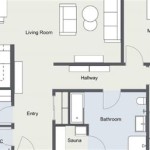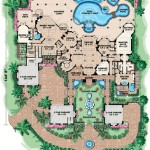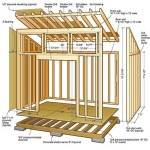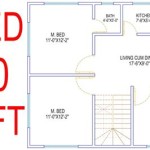Universal design in house plans refers to the architectural concept of creating homes that accommodate individuals of all abilities, including those with disabilities, seniors, and families with young children. It encompasses a range of features, such as wide hallways, accessible doorways, and adaptable spaces, ensuring that everyone can access and use the home comfortably.
In practice, universal design is not limited to specialized homes for individuals with specific disabilities. Rather, it integrates inclusive elements into the design of everyday homes, making them more accessible and convenient for a broader range of users. For example, a house plan that incorporates a zero-threshold entry and an open-floor design allows for easy wheelchair access and mobility throughout the home.
The benefits of universal design extend beyond accessibility. These homes offer increased comfort and safety for all residents, regardless of age or ability. They can also enhance the value and marketability of the property by creating a more inclusive and livable living space. As our population ages and the demand for accessible housing grows, the principles of universal design are becoming increasingly important in modern home design.
Universal design in house plans encompasses a range of important considerations to ensure accessibility and comfort for all users. Here are 9 key points to keep in mind:
- Wide hallways
- Accessible doorways
- Adaptable spaces
- Zero-threshold entry
- Open-floor design
- Universal kitchen design
- Accessible bathrooms
- Smart home technology
- Outdoor accessibility
By incorporating these elements into house plans, architects and builders can create homes that are not only accessible but also comfortable and stylish for everyone.
Wide hallways
Wide hallways are an important aspect of universal design in house plans. They provide ample space for wheelchairs, walkers, and other mobility aids to navigate comfortably. Wide hallways also benefit families with young children, who may need extra space to move around safely.
- Accommodate wheelchairs and mobility aids: Wide hallways allow wheelchairs and other mobility aids to pass through easily without bumping into walls or furniture. This is especially important in areas such as the kitchen, bathroom, and laundry room, where users may need to maneuver around obstacles.
- Provide space for family activities: Wide hallways create more space for family activities, such as playing games, walking together, or helping children with homework. They also reduce the risk of accidents by providing more room for people to move around without bumping into each other.
- Enhance accessibility for all: Wide hallways benefit everyone, regardless of age or ability. They make it easier for people to carry large objects, move furniture, and navigate the home safely.
- Add a sense of spaciousness: Wide hallways can make a home feel more spacious and inviting. They create a sense of openness and flow, which can be especially beneficial in smaller homes.
The recommended minimum width for hallways in universal design is 36 inches (91 cm). However, wider hallways are always better, especially in homes where multiple people may need to use mobility aids.
Accessible doorways
Accessible doorways are a crucial aspect of universal design in house plans. They allow people with disabilities, seniors, and families with young children to enter and exit the home safely and easily. Accessible doorways typically have the following features:
- Wider doorways: Accessible doorways are wider than standard doorways, typically measuring 36 inches (91 cm) or more in width. This allows wheelchairs and other mobility aids to pass through easily.
- Clear floor space: There should be clear floor space on both sides of the doorway to allow for easy maneuvering. This space should be at least 30 inches (76 cm) wide.
- No raised thresholds: Raised thresholds can be a tripping hazard for people with mobility impairments. Accessible doorways should have zero-threshold entries, which means that the floor level is the same on both sides of the doorway.
- Lever handles: Lever handles are easier to use for people with limited hand mobility. They should be installed on both sides of the doorway.
In addition to these basic features, accessible doorways can also include additional features to enhance usability, such as:
- Automatic door openers: Automatic door openers can be installed to allow people with disabilities to open the door without using their hands.
- Visual cues: Visual cues, such as contrasting colors or tactile strips, can help people with visual impairments locate the doorway.
- Signage: Clear signage can help people with cognitive disabilities understand how to use the doorway.
Accessible doorways are an essential part of universal design in house plans. They ensure that everyone can enter and exit the home safely and easily, regardless of their age or ability.
Adaptable spaces
Adaptable spaces are an important aspect of universal design in house plans. They allow homes to be easily modified to meet the changing needs of occupants over time. This is especially important for people with disabilities, seniors, and families with young children, who may need to make modifications to their homes as their needs change.
- Flexible room layouts: Adaptable spaces can be easily reconfigured to accommodate different uses. For example, a spare bedroom could be converted into a home office or a guest room. Flexible room layouts can also be used to create multi-generational homes, where different generations can live together comfortably.
- Adjustable fixtures: Adjustable fixtures, such as height-adjustable kitchen counters and sinks, allow users to customize the space to meet their specific needs. This is especially important for people with disabilities, who may need to make adjustments to accommodate their wheelchairs or other mobility aids.
- Universal design features: Adaptable spaces should incorporate universal design features, such as wide hallways, accessible doorways, and zero-threshold entries. This ensures that the space can be accessed and used by everyone, regardless of their age or ability.
- Future-proofing: Adaptable spaces can be future-proofed by including features that may not be needed immediately, but could be useful in the future. For example, a home could be built with reinforced walls to accommodate the future installation of grab bars in the bathroom.
Adaptable spaces are an essential part of universal design in house plans. They allow homes to be easily modified to meet the changing needs of occupants over time, ensuring that everyone can live comfortably and safely in their home.
Zero-threshold entry
A zero-threshold entry is a type of doorway or entrance that has no raised threshold. This means that the floor level is the same on both sides of the doorway, creating a smooth and seamless transition. Zero-threshold entries are an important aspect of universal design in house plans, as they allow people with disabilities, seniors, and families with young children to enter and exit the home safely and easily.
Traditional doorways often have a raised threshold, which can be a tripping hazard for people with mobility impairments. Zero-threshold entries eliminate this hazard, making it easier for people to enter and exit the home without assistance. This is especially important for people who use wheelchairs, walkers, or other mobility aids.
In addition to safety, zero-threshold entries also provide other benefits. They create a more seamless and aesthetically pleasing transition between the interior and exterior of the home. They also allow for easier movement of furniture and other large objects.
Zero-threshold entries can be incorporated into any type of home, regardless of the architectural style. They are a simple and cost-effective way to make a home more accessible and comfortable for everyone.
When designing a zero-threshold entry, it is important to consider the following factors:
- Slope: The slope of the entry should be gradual enough to allow for easy wheelchair access. The maximum recommended slope is 1:12.
- Width: The entry should be wide enough to accommodate wheelchairs and other mobility aids. The minimum recommended width is 36 inches (91 cm).
- Surface: The surface of the entry should be slip-resistant and easy to clean.
- Weatherproofing: The entry should be weatherproofed to prevent water from entering the home.
Open-floor design
Open-floor design is a type of home design that minimizes the use of walls and partitions to create a more spacious and flowing living space. This type of design is often used in universal design house plans, as it can improve accessibility and comfort for people with disabilities, seniors, and families with young children.
- Improved accessibility: Open-floor plans eliminate barriers such as walls and narrow hallways, making it easier for people with mobility impairments to navigate the home. This is especially important for people who use wheelchairs or other mobility aids.
- Increased visibility and supervision: Open-floor plans allow for greater visibility and supervision throughout the home. This can be beneficial for families with young children, as parents can easily keep an eye on their children from different parts of the house. It can also be beneficial for people with cognitive impairments, as they may be less likely to become disoriented or lost in an open-floor plan.
- Enhanced social interaction: Open-floor plans promote social interaction by creating a central gathering space where family and friends can connect. This is especially important for people who spend a lot of time at home, such as seniors or people with disabilities.
- More natural light: Open-floor plans often have fewer walls and more windows, which allows for more natural light to enter the home. This can create a more cheerful living environment and reduce the need for artificial lighting.
Open-floor design is not without its challenges. One potential drawback is that it can reduce privacy and sound control. However, these issues can be mitigated with careful planning and the use of strategic room dividers or privacy screens.
Universal kitchen design
Universal kitchen design incorporates features that make the kitchen accessible and usable for people of all abilities, including those with disabilities, seniors, and families with young children. Universal design principles can be applied to all aspects of the kitchen, from the layout and cabinetry to the appliances and fixtures.
One important aspect of universal kitchen design is creating a clear and accessible work triangle. The work triangle is the imaginary triangle formed between the sink, stove, and refrigerator. In a universal kitchen design, the work triangle should be designed to allow for easy movement and access, regardless of the user’s mobility level. This means avoiding obstacles and providing ample space for maneuvering.
Another important aspect of universal kitchen design is providing adjustable and adaptable features. For example, countertops and sinks can be height-adjustable to accommodate users of different heights. Cabinetry can be designed with pull-out shelves and drawers to make it easier for users to reach items. Appliances can be chosen with accessible controls and features, such as front-loading ovens and dishwashers.
Universal kitchen design also includes features that enhance safety and convenience. For example, non-slip flooring can help prevent falls. Adequate lighting is essential for visibility and safety. Well-placed grab bars can provide support and stability for users with mobility impairments.
By incorporating universal design principles into the kitchen, it is possible to create a space that is accessible, usable, and safe for everyone.
Accessible bathrooms
Accessible bathrooms are designed to be safe and easy to use for people of all abilities, including those with disabilities, seniors, and families with young children. Universal design principles can be applied to all aspects of the bathroom, from the layout and fixtures to the finishes and accessories.
- Roll-in showers: Roll-in showers are designed to be accessible to people who use wheelchairs. They have a zero-threshold entry and a sloped floor that drains water away from the user. Roll-in showers can be equipped with a variety of features, such as grab bars, shower seats, and hand-held shower wands.
- Grab bars: Grab bars are essential for providing support and stability in the bathroom. They can be installed in a variety of locations, such as around the toilet, in the shower, and next to the sink. Grab bars should be securely fastened to the wall and spaced appropriately for the user’s needs.
- Accessible toilets: Accessible toilets are designed to be higher than standard toilets and have a comfort-height seat. They may also have features such as elongated bowls, grab bars, and touchless flushing mechanisms.
- Non-slip flooring: Non-slip flooring is essential for safety in the bathroom. It can help to prevent falls, especially for people who have difficulty walking or balancing.
By incorporating universal design principles into the bathroom, it is possible to create a space that is accessible, usable, and safe for everyone.
Smart home technology
Smart home technology can play a significant role in creating a more accessible and comfortable living environment for people of all abilities. By incorporating smart home features into house plans, it is possible to create a home that is responsive to the needs of its occupants and can adapt to changing needs over time.
- Automated lighting: Automated lighting systems can be controlled remotely via a smartphone app or voice commands. This can be especially beneficial for people with mobility impairments or cognitive disabilities, as it allows them to control the lighting in their home without having to physically reach for a switch. Automated lighting can also be programmed to turn on and off at specific times, which can be helpful for people with memory impairments or dementia.
- Smart thermostats: Smart thermostats can be controlled remotely to adjust the temperature in the home. This can be beneficial for people with mobility impairments or chronic health conditions, as it allows them to control the temperature in their home without having to get up and down. Smart thermostats can also be programmed to adjust the temperature automatically based on the time of day or the presence of occupants.
- Voice-activated assistants: Voice-activated assistants, such as Amazon Alexa and Google Home, can be used to control a variety of smart home devices, including lights, thermostats, and door locks. This can be especially beneficial for people with mobility impairments or cognitive disabilities, as it allows them to control their home environment using only their voice. Voice-activated assistants can also be used to provide information, such as the weather forecast or news updates.
- Remote door locks: Remote door locks can be controlled remotely via a smartphone app or voice commands. This can be beneficial for people with mobility impairments or cognitive disabilities, as it allows them to lock and unlock the door without having to physically reach for a key. Remote door locks can also be programmed to lock and unlock automatically when the occupant leaves or arrives home.
Smart home technology is a rapidly evolving field, and new and innovative products are being developed all the time. As smart home technology becomes more affordable and accessible, it is likely to play an increasingly important role in creating more accessible and comfortable homes for people of all abilities.
Outdoor accessibility
Outdoor accessibility is an important aspect of universal design in house plans. It ensures that people of all abilities, including those with disabilities, seniors, and families with young children, can safely and easily access and enjoy the outdoor spaces of their home.
One important aspect of outdoor accessibility is providing level and stable pathways. Pathways should be wide enough to accommodate wheelchairs and other mobility aids, and they should be free of obstacles and tripping hazards. Ramps can be used to provide access to raised areas, such as porches and decks.
Another important aspect of outdoor accessibility is providing accessible seating. Outdoor seating should be sturdy and comfortable, and it should be placed in areas that are shaded from the sun and protected from the elements. Tables and other surfaces should be at a height that is accessible to people of all abilities.
In addition to pathways and seating, other important aspects of outdoor accessibility include:
- Accessible play areas: Play areas should be designed to be accessible to children of all abilities. This includes providing ramps, wide pathways, and adaptive play equipment.
- Accessible gardens: Gardens can be made accessible by raised beds, wide pathways, and accessible tools and equipment.
- Accessible pools and spas: Pools and spas can be made accessible by ramps, lifts, and other adaptive equipment.
By incorporating outdoor accessibility features into house plans, it is possible to create a home that is truly accessible and enjoyable for everyone.










Related Posts








